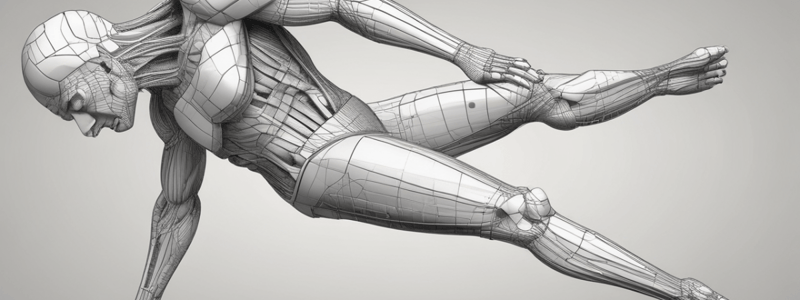Podcast
Questions and Answers
What is the main function of the patella?
What is the main function of the patella?
- To alter the length of the lower extremity
- To increase congruency of the posterior articular cartilage (correct)
- To provide lateral stability to the knee joint
- To provide mobility for ambulation
Which bone has no function in the main joints?
Which bone has no function in the main joints?
- Fibula (correct)
- Patella
- Femur
- Tibia
What is the intercondylar groove?
What is the intercondylar groove?
- An indentation where the patella lies (correct)
- A muscle that flexes the knee
- A ligament that connects the femur and tibia
- A bony structure in the tibial plateau
What is the characteristic of the knee joint?
What is the characteristic of the knee joint?
What is the primary function of the knee joint?
What is the primary function of the knee joint?
What is the primary function of the femur in the knee joint?
What is the primary function of the femur in the knee joint?
What is the significance of the tibial plateau in knee biomechanics?
What is the significance of the tibial plateau in knee biomechanics?
What is the characteristic of the patella that allows it to move smoothly in the knee joint?
What is the characteristic of the patella that allows it to move smoothly in the knee joint?
What is the role of the fibula in knee biomechanics?
What is the role of the fibula in knee biomechanics?
What is the significance of the congruency of the patella in knee biomechanics?
What is the significance of the congruency of the patella in knee biomechanics?
What is the primary function of the knee joint?
What is the primary function of the knee joint?
Which of the following bones forms the knee joint?
Which of the following bones forms the knee joint?
What is the significance of the intercondylar groove?
What is the significance of the intercondylar groove?
What is the role of the fibula in knee biomechanics?
What is the role of the fibula in knee biomechanics?
What is the characteristic of the patella that allows it to move smoothly in the knee joint?
What is the characteristic of the patella that allows it to move smoothly in the knee joint?
Flashcards are hidden until you start studying
Study Notes
Knee Biomechanics Basics
- The knee joint alters the length of the lower extremity, provides stability during weight-bearing, and enables mobility for ambulation.
Key Bony Structures
- The femur has femoral condyles, which feature an intercondylar groove where the patella lies.
- The tibial plateau is a crucial bony structure in the knee joint.
- The fibula plays a role in alignment and lateral stability, but has no direct function in the main joints.
- The patella is a sesamoid bone that contributes to congruency, with posterior articular cartilage.
Knee Biomechanics Basics
- The knee joint alters the length of the lower extremity, provides stability during weight-bearing, and enables mobility for ambulation.
Key Bony Structures
- The femur has femoral condyles, which feature an intercondylar groove where the patella lies.
- The tibial plateau is a crucial bony structure in the knee joint.
- The fibula plays a role in alignment and lateral stability, but has no direct function in the main joints.
- The patella is a sesamoid bone that contributes to congruency, with posterior articular cartilage.
Knee Biomechanics Basics
- The knee joint alters the length of the lower extremity, provides stability during weight-bearing, and enables mobility for ambulation.
Key Bony Structures
- The femur has femoral condyles, which feature an intercondylar groove where the patella lies.
- The tibial plateau is a crucial bony structure in the knee joint.
- The fibula plays a role in alignment and lateral stability, but has no direct function in the main joints.
- The patella is a sesamoid bone that contributes to congruency, with posterior articular cartilage.
Studying That Suits You
Use AI to generate personalized quizzes and flashcards to suit your learning preferences.




